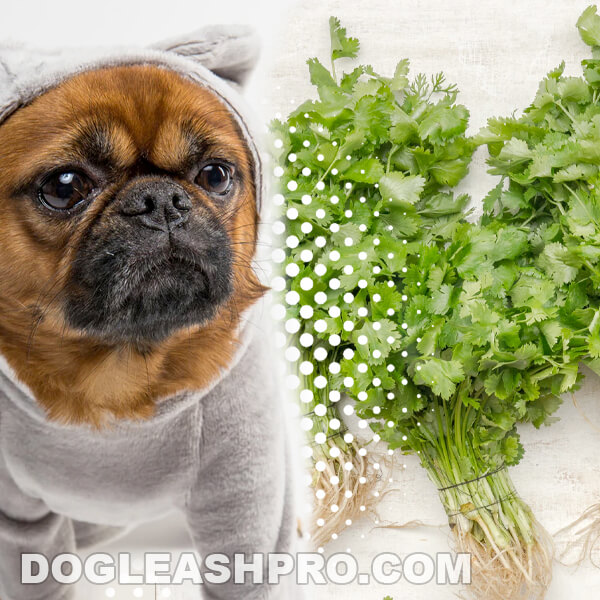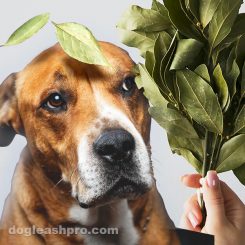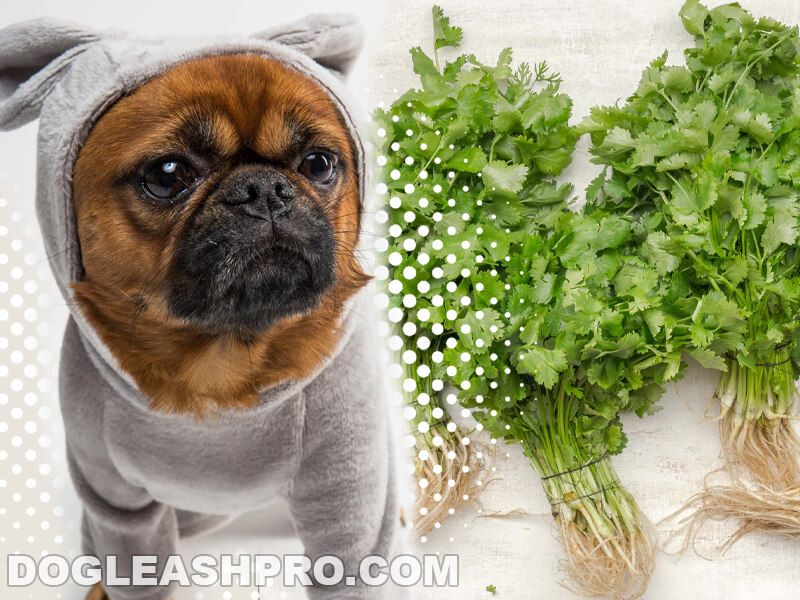
If you’re making a dish with an annual herb like Cilantro, you’re probably wondering if your dogs can have some. After all, the delicate and gentle green leaves are not only tasty but also provide us with many health benefits. But can the same be said for our dogs? Can dogs eat Cilantro and reap the same health benefits? Here is the short answer for now.
Can dogs eat Cilantro? Yes, dogs can eat Cilantro in moderation as this herb contains essential vitamins and minerals that are great for dogs. Cilantro also helps to soothe upset stomachs and relieve digestion issues in dogs. While it’s good for dogs, it should not substitute your dog’s main diet.
Table of Contents
Can dogs have Cilantro?
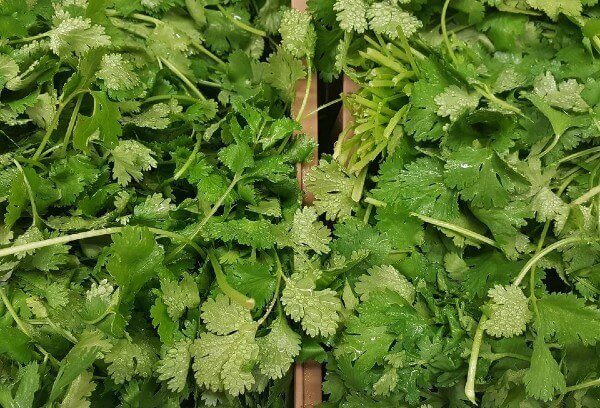
Yes, dogs can have Cilantro in moderation. This herb contains many essential vitamins and minerals that are extremely beneficial to your canine friend’s health. Before we go into the specific vitamins and minerals this herb contains, let’s take a look at what Cilantro is.
What is Cilantro?
Cilantro is an annual herb and while you can eat all parts of this plant, most prefer using the delicate fresh bright green leaves as well as the flavorful stalks as garnish or seasoning in their cooking or dishes.
There are some that will also use the dried seeds from the plant as a spice. The dried seeds of this herb are known as coriander and they are usually used as coriander spices.
As we can see, this plant is versatile and it can be found in many Indian, Chinese, Middle Eastern, and Mexican recipes. This is why Cilantro is also known as coriander, Chinese parsley, dhania, or Mexican parsley. In fact, the Spanish translation for coriander is cilantro.
Many people get confused between Cilantro and coriander so here is the clarification.
In the US, the word “Cilantro” refers to the green fresh leaves. In many European countries as well as the UK, people refer to both the green leaves and the spice as coriander. In India, they used the word “dhania” to refer to the green leafy herb in order to differentiate the leaves from coriander seeds.
So if you’re in the US and you’re wondering, “Can dogs eat Cilantro?” or you’re in the UK or European nations and you’re wondering, “Can dogs eat coriander?” the short answer is yes. In this article, we’ll discuss Cilantro, specifically its fresh green delicate leaves.
You might also like: Can Dogs Eat Sunflower Seeds?
Is Cilantro bad for dogs?
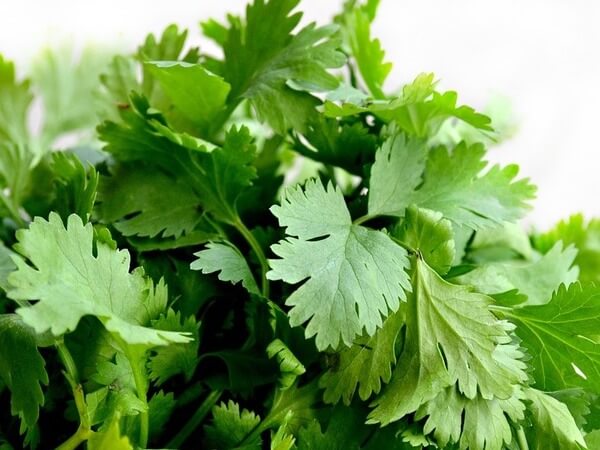
No, Cilantro is not bad for dogs. However, if you feed your dogs too much Cilantro, they may have mild digestive issues such as diarrhea, vomiting, and nausea.
When it comes to introducing new food to your canine friends, make sure to introduce it slowly and gradually. Avoid adding too much Cilantro at one time. Suddenly giving your pooch too much of it can be overwhelming, surprising, and scary for your pooch.
Adding a small amount to his meal will allow him to gradually get used to the Cilantro and explore the taste without feeling overwhelmed by it.
Is Cilantro good for dogs?
Yes, Cilantro is good for dogs in moderation. Dog owners can feed their pooch Cilantro as an occasional treat or add a small amount of Cilantro to their high-quality dog food from time to time.
Cilantro provides many health benefits to our four-legged friends.
Nutritional Profile of Cilantro (0.25 cups or 4 grams)
| Name, Unit | Amount |
| Calories, cal | 0.92 |
| Sugar, g | 0.035 |
| Sodium, mg | 1.84 |
| Carbohydrate, g | 0.147 |
| Total Fat, g | 0.021 |
| Protein, g | 0.085 |
| Fiber, g | 0.112 |
| Iron, mg | 0.071 |
| Water, g | 3.69 |
| Calcium, mg | 2.68 |
| Magnesium, mg | 1.04 |
| Phosphorus, mg | 1.92 |
| Potassium, mg | 20.8 |
| Zinc, mg | 0.02 |
| Copper, mg | 0.009 |
| Manganese, mg | 0.017 |
| Selenium, µg | 0.036 |
| Vitamin A, µg | 13.5 |
| Vitamin A, IU | 270 |
| Vitamin B-6, mg | 0.006 |
| Vitamin C, mg | 1.08 |
| Vitamin E, mg | 0.1 |
| Vitamin K, µg | 12.4 |
| Thiamin, mg | 0.003 |
| Riboflavin, mg | 0.006 |
| Niacin, mg | 0.044 |
| Pantothenic acid, mg | 0.023 |
| Folate, µg | 2.48 |
| Carotene, beta, µg | 157 |
| Carotene, alpha, µg | 1.44 |
As we can see, a quarter cup of Cilantro is cholesterol-free, low in calories, and has high water content. There is less than 1 calorie with an abundance of vitamins and minerals.
Cilantro has detoxifying properties that help get rid of heavy metals in your dog’s body
Additionally, the fresh green leaves contain the following properties and act as a detoxifying agent:
- Antifungal.
- Antiseptic.
- Anti-inflammatory.
- Antimicrobial.
- Chelating properties.
These properties, especially the chelating properties help to remove the heavy metals from your dog’s body. Essentially, by eating some Cilantro, your dog’s body will be cleansed of heavy metals, including mercury.
That’s because the chelating compounds in Cilantro bind to toxic metals that have been accumulated in the dog’s body tissues and helps to get rid of it from the dog’s body.
Dogs can be exposed to heavy metals through certain types of vaccinations, environmental pollutants, drinking contaminated water, or getting in contact with certain household products.
Simply add a small amount of Cilantro to your dog’s daily diet and let your dog’s body detox naturally.
You might also like: What Can Dogs Drink Besides Water?
Vitamin A, C, and E in Cilantro provides dogs with antioxidant support
Cilantro is rich in antioxidants like vitamin A, C, and E. Antioxidants are important because they protect the dog’s cells against the effects of harmful free radicals. Harmful free radicals are responsible for many diseases including cancer and heart disease.
Harmful free radicals damage cells so they can cause aging, inflammation, and illness in dogs.
Additionally, Cilantro has beta-carotene, which is another major antioxidant vitamin. In fact, in just a quarter cup of Cilantro, there are 157µg of beta-carotene.
Cilantro has phenolic compounds which help your dog fight against infections
As mentioned above, Cilantro contains both antifungal and antibacterial properties. If your pooch has infections related to his digestive system, sprinkling some Cilantro to his main meal will help his body fight off the infections.
Also, feeding your pooch a little bit of the fresh green Cilantro leaves will fight against foodborne infections and even get rid of Salmonella enterica.
Is Cilantro safe for dogs?
As we can see, Cilantro is safe for dogs to eat. According to the American Society for the Prevention of Cruelty to Animals (ASPCA), Cilantro is not poisonous or toxic to dogs. However, you’ll want to confirm that your pup does not have any plant-based allergies first before giving them Cilantro to err on the side of safety.
When it comes to feeding your canine friends Cilantro, keep in mind that moderation and consistency are key. That’s because giving your pooch too much Cilantro suddenly or very often will actually upset your dog’s stomach as we discussed above.
You’ll want to have a routine after introducing Cilantro to your furry family members.
How to serve Cilantro to your dog
While the Cilantro seeds and powder are safe for dogs to eat, it’s best to stick to the fresh Cilantro leaves. Since the green fresh leaves contain more vitamins and minerals, your pooch will receive more health benefits from them.
To properly serve the Cilantro to your furry friends, you’ll want to rinse the Cilantro leaves, break them off the stalk and then chop the leaves into fine small pieces. You can then add them to your pup’s main meal.
So, can dogs eat Cilantro?
Cilantro is a versatile plant that contains many essential vitamins and minerals that are beneficial to our furry friends, including vitamins A, B, C, E, and K.
Be sure to only feed your pooch Cilantro in small moderate amounts to avoid negative side effects such as diarrhea, vomiting, and nausea. You can give it as a doggy treat. Some owners will add Cilantro to their dog’s main diet as a supplement that will enhance their furry family member’s health.
Before you feed your K9 pals Cilantro, make sure they are not allergic to this herb and consult with your vet if you suspect your pooch may have food allergies.
DISCLAIMER: THIS WEBSITE DOES NOT PROVIDE MEDICAL ADVICE
The information, including but not limited to, text, graphics, images and other material contained on this website are for informational purposes only. No material on this site is intended to be a substitute for professional veterinary advice, diagnosis, or treatment. Always seek the advice of your veterinarian or other qualified health care provider with any questions you may have regarding dietary needs.
Resources:
https://en.wikipedia.org/wiki/Coriander

With over five years of specialized experience as an animal writer, my expertise lies in dog nutrition, health, behavior, grooming, and training. I am dedicated to delivering helpful and informative content that caters to the well-being of our furry friends. My primary goal is to empower pet owners with knowledge and ensure our canine companions thrive in health and happiness. In my free time, I love volunteering at local dog rescue centers.
